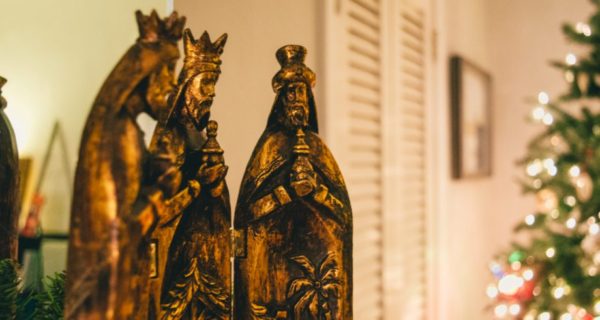When Jesus therefore was born in Bethlehem of Judah, in the days of king Herod, behold, there came wise men from the east to Jerusalem, saying, “Where is He that is born King of the Jews? For we have seen His star in the east, and are come to adore Him…” and behold the star which they had seen in the east, went before them, until it came and stood over where the Child was. And seeing the star they rejoiced with exceeding great joy. And entering into the house, they found the Child with Mary His mother, and falling down they adored Him; and opening their treasures, they offered Him gifts; gold, frankincense, and myrrh. -The Gospel of Saint Matthew, 2:1-2, 9-12
The Feast of the Epiphany commemorates the threefold manifestation of our Lord Jesus Christ in His earthly life, His baptism, the wedding feast of Canna, and the visit of the Magi. Of these three, Western Catholicism has held the first revelation to the Gentiles in the primary place of recollection, and with good cause. Ancient tradition holds that there were three principle Magi, men fere reges (like unto kings), St. Melchior of Persia, St. Caspar of India, and St. Balthazar of Ethiopia (or Arabia), embodying the three great gentium of Mankind, and forming in themselves a microcosm of the Sacrétemporal understanding of the world.
The first of these, St. Melchior, is said to have come from Persia, the High Kingdom of Parthia. Of the three he would have been the closest to the classical sense of Magus, a follower of Zoroaster, and a priest of Ahura Mazda, the lord of wisdom. The ascription of the gift of gold to him is particularly fitting as representative of the land of Cyrus the Great, the proto-Imperium of the Ancient world in which both the symbolism of the Imperial Eagle and the Imperial Crown find their origin. To St. Melchior is ascribed the patronage of Europe, as the archetype of European Civilization originated in his native land. (A Persian tribe, the Alans, later migrated to Europe and were absorbed into the local Roman, Celtic, and Germanic populations, thus sealing the bond between this Persian saint and the lands of the West.)
The second of these, St. Caspar, is said to have come from Southern India, in the region of Piravom. He would have been of the Brahminical caste, devoted to austerity, and thus the ascription of the gift of Arabian frankincense to him is not only fitting in so far as it signifies the central position of his land in the Eastern trade routes. It is even more fitting as through his long penitence he would have been the first to recognize the Divinity of the Christ Child. To him is ascribed the patronage of Asia and the Indies (and by extension those who indigenously inhabited the Americas in the “Far East”).
And lastly the third of these, St. Balthazar, is said to have come from the black Sabaeans (Ethiopians) in Yemen. He was perhaps, an oracle of Ta’lab, seeking for hidden signs in the stars. The ascription to him of the gift of myrrh by which Our Lord was anointed to be buried after His Passion is indeed fitting, because of all the families of peoples, his peoples have by far suffered the most hardships in this vale of tears, and yet were among the very first to whom the saving Light of Truth was given. To St. Balthazar is ascribed the patronage of Africa, to which lands Our Lord guided St. Philip the Deacon, and also St. Matthew the Apostle, in the earliest days of the Great Commission.
These three men of wisdom were not Kings in the traditional sense (that is viceregents and vicars of the Roman Emperor), yet they personify the virtues of the Good Ruler, one who has great love of wisdom and yet also great humility. In their adoration of the Holy King of Kings and Emperor of Heaven, they become the archetypes of all Catholic rulers. In their almost inseparable unity after receiving this revelation of the Truth, these three of so completely disparate peoples signify the proper attitude of Catholics united in Christ, of whatever country or ethnicity. The great glory of free and united Christendom is foreshadowed in these three saints who undertook the journey of Faith in search of the True.
After the Resurrection of Our Lord it is said that the Three Magi were baptized by St. Thomas the Apostle, whose coming they had awaited in India. Journeying together once more, they continued to spread the faith in whatever lands they ventured to, until each gave his life (some say in Arabia, others in Armenia, still others in the far lands of China) for the Wisdom whom he had spent his life in search of.
Eventually the bodies of the three magi were returned to St. Melchior’s native land of Persia, and thence to Constantinople by the mother of Emperor Constantine, St. Helena. Taken to Milan by Bishop Eustorgius, Sts. Melchior, Caspar, and Balthazar were translated to their final resting place in Cologne on the Rhine (where their relics remain to this day) by Holy Roman Emperor Frederick I Barbarossa in A.D. 1164. Sadly, the many of the peoples of the homelands of the Three Kings have fallen from the Ancient and Apostolic Faith through persecution and hardship. May God grant through their intercession a revival of the Catholic Church in these lands, and in all lands under their patronage.
S. Caspar+ S. Melchior+ S. Balthazar+ Ora Pro Nobis
